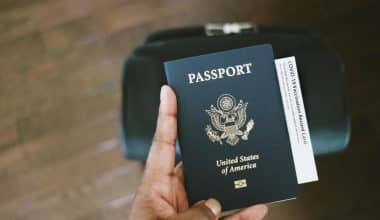A logistics business is like a distinct environment with its set of terms and rules, which might be perplexing or unpleasant to someone joining for the first time. If you’re unfamiliar with shipping, the word “Bill of Lading” is one of the terminologies you will hear. Meanwhile, as you start exporting your goods internationally and engage in trade, you’ll also come across many crucial shipping statements. However, here, we define what a bill of lading is, who issues it, the form, tracking, 4 functions, and more. Read on!
What Is A Bill of Lading?
A bill of lading (BoL or B/L) is a legal form or document that outlines the terms of a shipment of goods. It is a contract between the shipper and the carrier, and it serves as a receipt for the sent goods.
The BoL lists the type and quantity of the delivered goods, the origin and destination of the shipment, and the terms of carriage. It is also a document of title, which means that it is usable for transferring ownership of the goods from the shipper to the consignee. To validate the bill of lading from the carrier ( who issues it), the shipper must sign the form, for tracking, and other 4 functions.
A bill of lading is one of the primary legal documents used to carry out transportation transactions by land, air, or water. As a result, it is the most crucial shipping document and the key to opening your logistics.
Who Issues Bill of Lading?
The “Carrier” (transportation company) has the authority to issue a Bill of Lading. When shipping goods by water, the carrier can use the Shipping Line (Vessel Operating Common Carrier) or an NVOCC (Non-Vessel Operating Common Carrier). Sometimes, they are referred as a Freight Forwarder (but not all shipping companies are NVOCCs).
Then, the BoL will contain important information about the shipment. It includes the names of the shipper and recipient, the origin and destination of the shipment, a description of the goods sent, and the date of the shipment. Additionally, the document also serves as a receipt for the shipped goods.
Is It Mandatory To Have A Bill of Lading?
A bill of lading is not always required. But it is best to have it, as it provides proof of the contract of carriage and it’s useful if a dispute arises. This means the bill of lading includes who Issues the form (carrier, forwarder, or freight broker), a list of the transported goods, the origin and destination of the shipment, and the date of the journey.
You can use a bill of lading form for tracking the shipment and to ensure the goods arrive at their destination safely. Meanwhile, the authorized representatives from both parties (the shipper and the carrier) must sign the form. If the bill of lading is lost, the shipper may be liable for the loss of the shipment.
For instance, when the parties sign the BoL and a problem occurs with the shipment, the form serves as evidence in resolving the issue. And if the shipment is financed, the BoL is also advantageous because it can act as collateral for the loan.
However, the bill of lading is an important document. It serves as a contract between the shipper and the carrier. The carrier is responsible for delivering the goods to the destination specified in the bill of lading, and the shipper is responsible for paying the freight charges, once the shipment becomes the consignee’s responsibility at the shipper’s dock. And if the goods are lost or damaged in transit, the document aids to file a claim with the carrier.
How Do You Track A Bill of Lading?
While a bill of lading must contain everything about the shipment, you can use it for tracking the shipment status and verifying when it reaches the recipient. Here are a few ways to track a BoL.
The most common way is to track the BoL number. The BoL number is a unique number the management assign to each form. You can find the number on the physical document or the shipping company’s website.
Another way to track a BoL is to track the container number or booking number. The container number is usually on the Bill of Lading form.
Furthermore, you can use the BoL number, container number, or booking number to track the shipment through the shipping company’s website or a third-party tracking website.
Are Bills of Lading Public Information?
International shipping firms typically use Bill of Lading (BoL) to describe the contents of a shipment. The U.S. ports collect the BoL document for clearing customs and tracking the shipment. So, when an accredited institution requests the document, the information will be made available to the public.
4 Functions Of A Bill of Lading
The 4 main functions of a bill of lading are as follows:
#1. To Serve As Proof Of Contract
The bill of lading is a legally binding document that outlines the terms of the transportation agreement between the shipper and the carrier. This contract serves to protect both parties in the event of any damages or discrepancies that may occur during the transport of the goods.
#2. To Act As A Receipt
The document serves as a receipt for the sent products. This document outlines the quantity and type of goods, as well as the date of shipment. The carrier signs the form to show that they received the goods.
#3. To Act As A Document Of Title
The BoL also serves as a document of title for the shipped goods. This means that the carrier holds the title to the goods until the goods get to the consignee. The carrier must sign the form to release the goods to the consignee.
#4. To Serve As A Negotiable Instrument.
BoLs represent a negotiable instrument, meaning they are usable for transferring ownership of the goods from one party to another. This makes them an important tool in international trade.
Is A Bill of Lading Proof Of Ownership?
A BoL often proves that the sender owns the goods. The sender can use this document to prove ownership if there is a dispute. Additionally, the BoL shows the sender is responsible for the goods until they reach the recipient’s destination.
What Is Bill of Lading vs Invoice?
A bill of lading is a legal document that represents a contract between a shipper and a carrier for the transportation of goods. An invoice is a document that itemizes the goods and services a customer purchased from a seller.
What Are The Advantages Of Bill of Lading?
There are several advantages to using a bill of lading.
- First, it provides a clear record of the transaction. You can use the document as evidence in the event of a dispute.
- Second, it aids obtain insurance for the shipment. This can protect the carrier and shipper’s rights in case of loss or damage during transit.
- Finally, it allows the shipper to track the shipment and know its location at all times.
Why Are There 3 Original Bills of Lading?
There are three original BoLs because BoL is a document of title and it is valuable. In addition, the carrier, shipper, and consignee require the originals. For example, the carrier needs it to transport the goods, the shipper needs it to prove the goods were shipped, and the consignee needs it to receive the goods.
What Is The Purpose Of A Bill of Lading?
The purpose of a BoL is to document the contents of a shipment. Both the shipper and the carrier use this document to keep track of the status of the package. The agreement between the shipper and the carrier is also written in the form.
What Is The Difference Between Bill of Lading And Shipping?
A BoL lists shipped items, the name of the shipper and receiver, and the mode of transportation. A shipping document outlines the shipping terms and conditions, such as the date and time of shipping, type of shipping, and insurance coverage. In other words, shipping contains directions for packaging and delivering products.
Does The Shipper Create The Bill of Lading?
The shipper or inland carrier may create the BoL, and it must be signed when the carrier picks up or takes control of the cargo. The boL certifies the carriage agreement and serves as payment authorization for the goods. Thus, the shipper may delegate the task of creating the document to the carrier, freight forwarder, or customs broker.
Does The Shipper Keep A Copy Of The BoL?
The shipper may keep a copy of the BOL for their records.
Does Every Shipment Have A Bill of Lading?
Not every shipment has a bill of lading, but most do. It is necessary to have this legally enforceable agreement to move items from Location A to Location B. However, every shipment must have a bill of lading, and it is the responsibility of the shipper to ensure that one is obtainable.
NOTE: A bill of lading is a document that lists shipped items, the origin and destination of the shipment, and other important information. When shipping goods, carefully review the document to ensure that all the information is accurate. If there are any discrepancies, contact the shipper to resolve the issue.
It is also important to note that the BoL is a legal document, and as such, it should be kept in a safe place. If you are ever in doubt about the contents, you should always consult with a lawyer or other legal expert.
Conclusion
A bill of lading is a crucial document in the shipping process. It serves as an agreement between the shipper and carrier, as well as a receipt for the forwarded goods. While the bill of lading is an essential form, it’s crucial to understand its functions and tracking before sending your merchandise. However, the above content contains everything you need to know.






